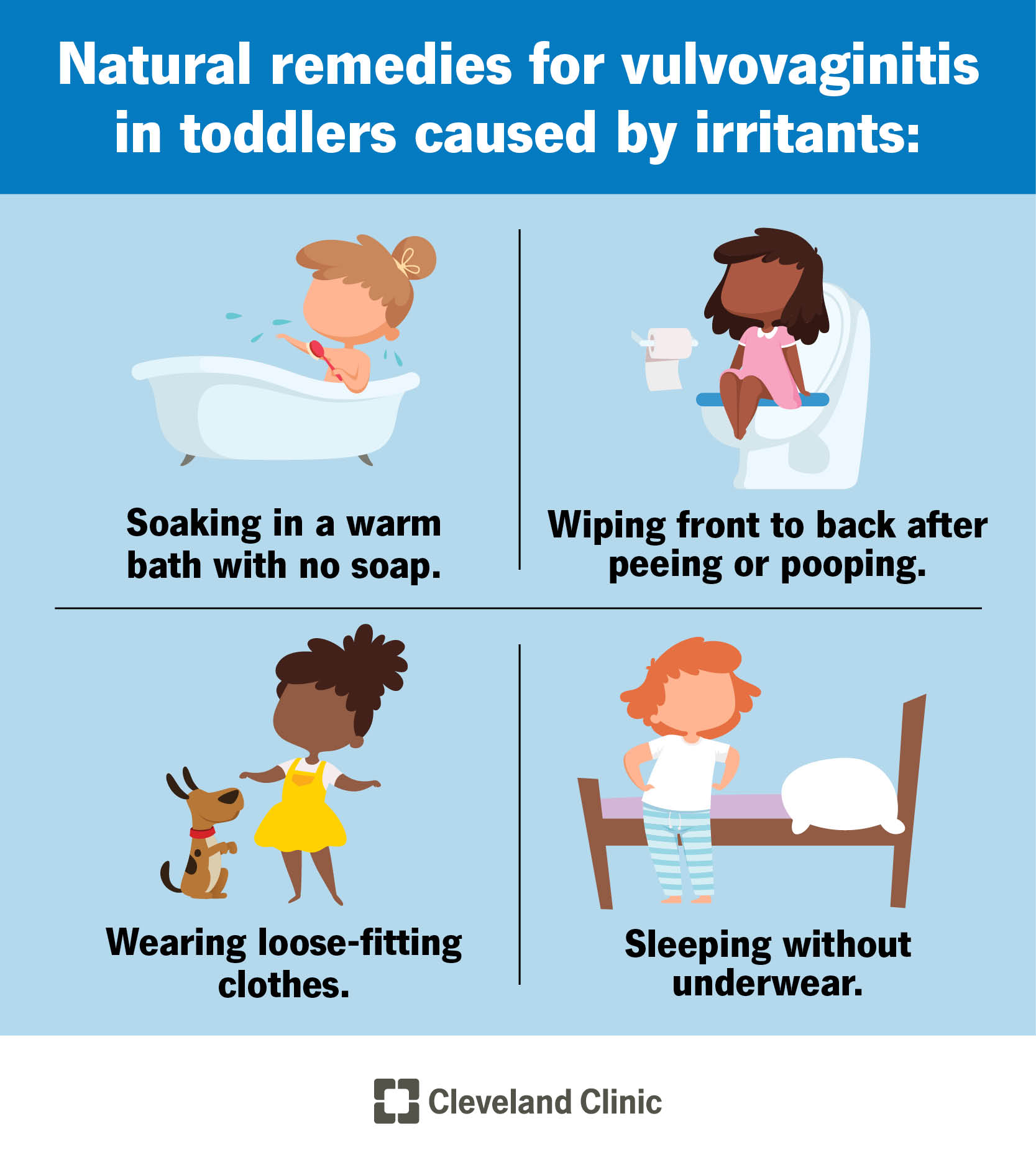Vulvovaginitis in toddlers is the inflammation or swelling of their vulva and vagina. Symptoms include redness, soreness and itching in your child’s vaginal area. The most common cause of vulvovaginitis in toddlers are irritants such as harsh soaps, bubble baths and tight-fitting clothing. Treatment typically involves eliminating the irritants.
Advertisement
Cleveland Clinic is a non-profit academic medical center. Advertising on our site helps support our mission. We do not endorse non-Cleveland Clinic products or services. Policy
Vulvovaginitis in toddlers is the swelling or inflammation of their vagina and vulva. Your child’s vulva is the area between their legs surrounding the opening of their vagina. Vulvovaginitis in toddlers, or pediatric vulvovaginitis, is a common problem that affects young girls.
Advertisement
Cleveland Clinic is a non-profit academic medical center. Advertising on our site helps support our mission. We do not endorse non-Cleveland Clinic products or services. Policy
Before puberty, your child isn’t making estrogen, which means the skin around their vulva is thin. In addition, your child lacks pubic hair and fatty labia, the lips of the vulva. This means they don’t have as much protection from possible irritation. Irritating products such as bubble baths, soaps, detergents and clothing can cause vulvovaginitis.
Without estrogen, mucus hasn’t had a chance to build up in your child’s vagina. Thick vaginal mucus protects against infection. Also, there’s a shorter distance between your child’s vagina and anus. This makes it easier for germs to spread from their anus (where there are lots of germs and poop) to their vagina.
Many young girls are still learning proper bathroom habits. This includes wiping from front to back to keep bacteria from their anus from tracking up their vagina or urethra. The urethra is where they pee, the connection to their bladder.
Vulvovaginitis is the most common gynecological problem in young girls. The condition makes up about 62% of gynecological problems seen by pediatricians.
Vulvovaginitis in toddlers may cause many uncomfortable symptoms in their vaginal area. These symptoms may include:
Advertisement
Your child lacks estrogen in their body before puberty. Without estrogen, the skin around their vulva is thin. Your child also doesn’t yet have pubic hair and fatty labia. Thicker skin, pubic hair and fatty labia provide protection from irritation. Irritants cause up to 75% of all vulvovaginitis cases in toddlers. Irritants may include:
Poor hygiene and bacterial infections can also team up to cause pediatric vulvovaginitis. During puberty, estrogen thickens your child’s vaginal mucus, which reduces the chance of infection. Before puberty, your child doesn’t have this protection. Also, there’s not as much space between your child’s vagina and anus, which makes it easier for bacteria to spread.
Your child may still be learning how to properly wipe themselves. If they don’t wipe carefully, urine can collect in their vagina and give bacteria a place to grow. If your child doesn’t wipe from front to back, fecal bacteria can transfer from their anus to their vagina as well. Bacteria can also spread by not washing their hands, picking their nose or sucking their thumb, and then touching their genital area.
Other causes of vulvovaginitis in toddlers may include:
Your child’s healthcare provider will ask about their medical history, including any recent infections. They’ll ask about your child’s symptoms, including when they started and what makes them better or worse. Their provider will ask about their toileting habits and hygiene. They’ll also ask you about any potential irritants that could cause the infection.
Advertisement
Your child’s healthcare provider will perform a physical examination. They’ll look at your child’s external vaginal area. Your child may feel uncomfortable, but you’ll stay in the room with them and the exam won’t hurt. If your child’s healthcare provider suspects a bacterial infection or sees discharge, they’ll collect a sample for testing. They’ll collect the sample using a wet swab smaller than the size of a Q-Tip. They’ll send the sample to a laboratory to test for bacteria.

Most of the time, you can treat your toddler’s vulvovaginitis with home remedies. Natural remedies for toddler vulvovaginitis caused by irritants include:
To help relieve symptoms, you can apply an emollient such as zinc oxide (Aquaphor®) or a steroid cream. But you should use steroid creams sparingly and discuss their use with your child’s healthcare provider.
If your child has a bacterial infection, your child’s healthcare provider will prescribe an antibiotic such as penicillin. Pediatric vulvovaginitis treatment for other causes include:
Advertisement
Vulvovaginitis is a common diagnosis in toddlers. Steps you can take to prevent vulvovaginitis in your toddler include:
Advertisement
Teaching your child about proper hygiene should treat and prevent future occurrences. If your toddler is toilet trained, make sure they’re:
Redness, soreness, itchiness and even vaginal discharge can be scary for a parent to see in their toddler. But vulvovaginitis is a common condition in young girls. It’s usually not serious and is most likely caused by an irritant. Try eliminating potential culprits, such as scented soaps or bubble baths. And make sure you’re teaching your child proper hygiene. If your child’s symptoms persist, call their healthcare provider. They’ll be able to confirm the diagnosis and determine the correct treatment. With proper treatment, your toddler will be feeling better in no time.
As your child grows, you need healthcare providers by your side to guide you through each step. Cleveland Clinic Children’s is there with care you can trust.

Last reviewed on 03/14/2022.
Learn more about the Health Library and our editorial process.